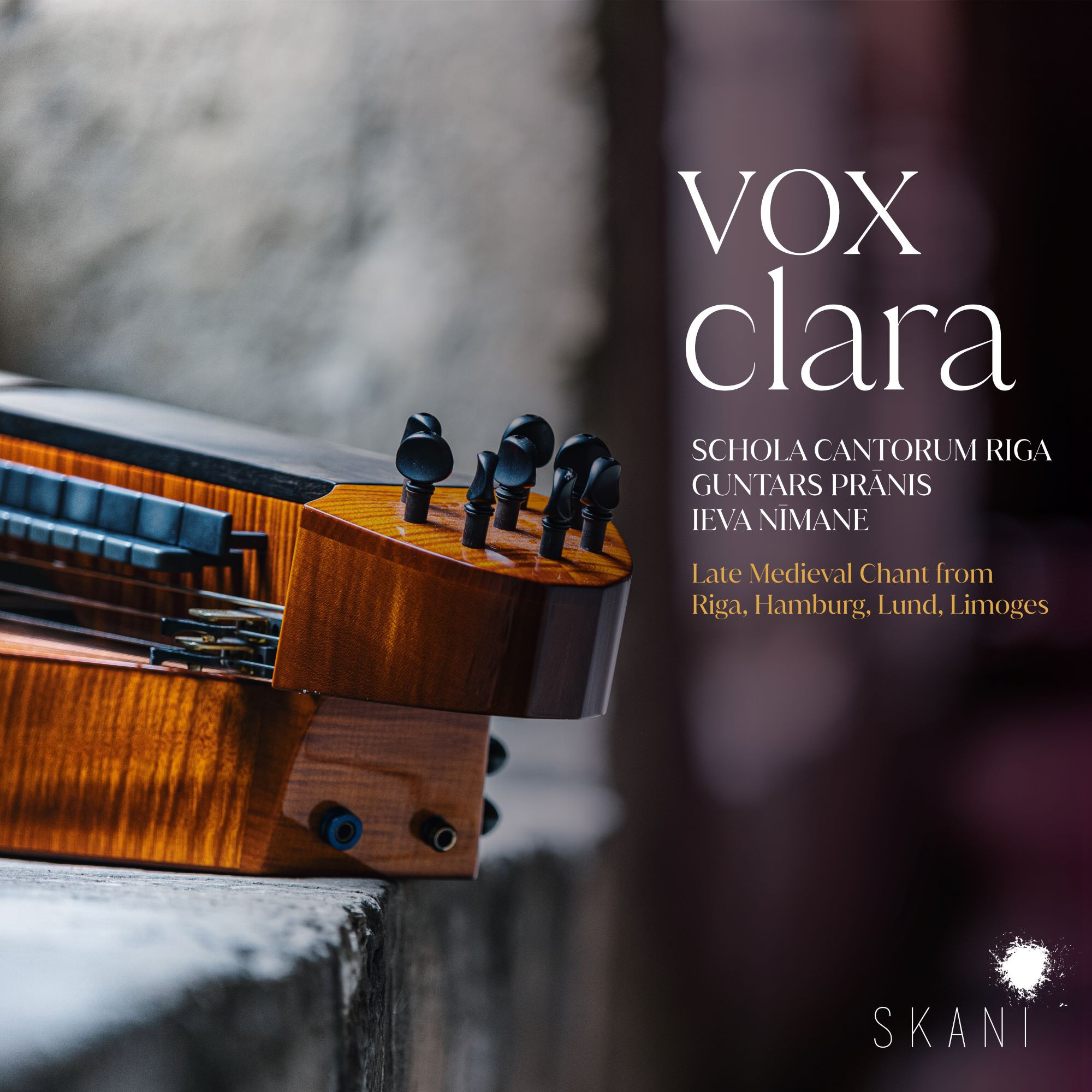"Choral singing has always been a speciality of the Scandinavian countries, and this collection of medieval chant from Latvia’s Riga, Germany’s Hamburg, Sweden’s Lund, and unexpectedly Limoges in France, is as stylish as one might expect. As the director Guntars Pranis of the vocal group Schola Cantorum Riga points out, it’s a myth that musicians and singers in medieval times only sang what they read in manuscripts; improvisation was central to their art. Christmas is the theme that runs through this CD, and, with the intensely virile sound of the male-voice choir of Riga Cathedral, we can get a vivid idea of what this music would have sounded like half a millennium ago."
★ ★ ★ ★ ☆
Michael Church
The Independent
_________________________________________________________
"Whether it’s the arching beauty of the “Veni Creator”, the comfortingly stolid “Pater Noster” or the graceful “Ave Maris Stella”, there’s a sense of plainchant as something immutable, eternal – a language we’ve always known and all share. But a new recording from the award-winning Schola Cantorum Riga reveals a tradition full of exibility and variation, even improvisation – music that, far from being fixed, evolves and adapts to different countries and contexts. The birth of plainchant is the birth of musical notation; the two traditions are so intertwined, so mutually dependent, that it’s hard to conceive a medieval performance tradition that was far from bound by or to those carefully illuminated neumes that decorate the pages of twelfth- and thirteenth century manuscripts. Instead, as Guntars Pranis and his musicians demonstrate here, often these notes were just the starting point for performances that blended ofifcial chant melodies with polyphonic and folk influences, voices with local instrumental textures and accompaniments.
The ensemble’s home town of Riga (at whose cathedral the Schola Cantorum is the resident male-voice choir) is the geographical centre of a recording that roams across northern Europe from Limoges to Hamburg and Lund in Sweden, offering a musical tour through subtly different styles and colours of chant.
Any expectations of severe musical simplicity are banished in the opening seconds of the recording. A drum sets up a marching pulse, quickly joined by the buzzing hum of the hurdy-gurdy, whose drone is the anchor for a flighty, bird-like recorder. There’s a processional energy to this “Res est admirabilis” – one of several non liturgical sacred songs that frame the hymns and antiphons included here.
After the ascetic, white-scrubbed approach of so many British groups to this repertoire, it’s refreshingly relaxed – an attempt to recreate not just the sound but the spirit of works that dissolve distinctions between sacred and secular. The singing itself is soft-edged, cloudy, solo verses delivered with a ballad singer’s fluid phrasing and inection, taking full advantage of the rhythmic freedom built into these works.
Some of the group’s interventions are subtle: the strange harmonies extrapolated from the familiar “Miserere” by Ieva Nimane’s evocative kokle (a kind of Baltic box zither), the wild instrumental dance that breaks out between verses of the Responsory “Ingrediente Domino”. Others are bolder, like the rustling, and rattling forest of sound effects that set the scene before “Unicornis captivator”, with its vivid descriptions of pelicans, crocodiles, lions and more, and – most striking – the collapse into an echoing Babel of drifting voices that cluster towards the end of “Gaude Maria” in what feels like an extraordinarily modern effect.
Home to the largest medieval church in the Baltics, Riga also houses the Riga Missal – the first musical document in Latvian history. This fifteenth-century manuscript is the source for one of several premiere recordings included here – the keening “Kyrie eleison ymas”, with its alternating verses of solo and unison chant. Six centuries after monks originally notated it, it’s hard not to feel chills when you hear the city once again filled with the same chant."
Alexandra Coghlan
The Tablet
_________________________________________________________
"Although in one sense a Christmas disc (many of the texts sing about related subjects), it would be churlish to exclude this lovely disc on the basis we're now in January. Imagining the sounds of medieval Riga, and dispelling any sense of stuffy, voice-bound-to-text performance practice, this is a collection of chants backed by instruments such as the bagpipes, hurdy gurdy and the kokle, a Baltic zither. It is a remarkable adventure.
The performers are the Schola Cantorum Riga the resident vocal group of Riga Cathedral (the largest cathedral of the Baltics); and the disc encompasses repertoire from their home city (in what would then have been known as Livonia rather than Latvia) as well as Hamburg, Lund and Limoges: unexpectedly cosmopolitan, one might suggest. Although we're in a different era, one might suggest this disc as a perfect companion to a previous disc recommended by Classical Explorer: The Suspended Harp of Babel on ECM, a celebration of the Estonian tradition in the music of Kreek.
The result of this mixing of instruments and late Medieval chant is spellbinding. The music includes example of elements of the ancient form of traditional Latvian vocal polyphony, Teikšana or saukšana (“saying” or “calling”), as can be heard in Miserere Mei, a Gergorian "cantus falsobordone". Veni Sancte Spiritus is sung in the early Livonian language, and the ensemble decided to sing the Latin words throughout the album in their local Latvian accent. These are important documents as well as being toe-curlingly beautiful. The "Kyrie eleison ymas" is from Riga Cathedral's 15th-century Riga Missal (Missale Rigense) manuscript.
Led by Guntars Prānis, himself an expert in his field, this disc celebrates in the liveliest, but also most profound, fashion how liturgical music sat alongside improvisation. The performances just sound alive. By taking music from various locations, we travel across medieval Europe while looking through a decidedly Latvian pair of eyes; it is a journey like no other (it even includes a chant about a unicorn), and is fully worthy of exploration."
Colin Clarke
Classical Explorer
_____________________________________________________________________________
The Latvian group bringing elements of traditional music into the performance of Late Medieval chant to give a taste of how the music might have sounded in Medieval Riga
The Schola Cantorum Riga was founded over twenty year ago, exploring Gregorian chant and other early music repertoires from the oldest manuscripts as well as performing contemporary composers such as Rihards Dubra. The group was founded by Guntars Prānis, who is still artistic director, and Pranis' research interests include the sacred music tradition of Riga in the context of various local practices and this feeds into the group's latest disc. Vox Clara on the Skani label features Schola Cantorum Riga and Guntars Prānis in late medieval chant from Riga, Hamburg, Lund (in Southern Sweden) and Limoges. The group is joined by Ansis Klucis (percussion), Ieva Nimane (recorders, bagpipes, kokle - a Latvian plucked string instrument belonging to the box zither family) whilst Pranis plays the hurdy gurdy.
The music comes from a 5th century Liber Hymnarius, a 12th century antiphonary from the Monastery of St Maur-des-Fosses, the 12th century Codex Saint Martial de Limoges, the 13th century Fontevrault Gradual (Limoges), the 14th century Hamburg Antiphonary, 14th century Codex di Perugia, 14th century Codex Engelburg, the 15th century Missale Rigense, and the Liber Scole Virginis, a medieval collection of Marian music in Lund. A wide variety of sources, but the focus is on the Northern Medieval cities of Hamburg, Riga and Lund, interwoven with some of the rich tradition of early polyphony from Limoges.
But these are no ordinary performances, as the line-up for the disc suggests. The performers are interested in the interweaving of the sacred with the local musical traditions, something that probably happened rather a lot. And they take the written manuscripts simply as the starting point. The use of hurdy-gurdy and bagpipes are documented in Latvian traditional music, and some of the performances include these as well as the early Latvian language and elements of Latvian traditional singing. The idea being to create a programme as it might have sounded in Medieval Riga. In his booklet note, Pranis points out that whilst the chant melodies would have been common to different establishments, each centre would have had its own way of singing them. A manuscript can only take us so far.
The chant on the disc is varied, certainly not a liturgical reconstruction, but a thread running through it is the theme of Christmas. There are two paraliturgical pieces, a Florentine lauda from the 14th century and a 15th century Sephardic song from Spain, but the sense of the wider musical landscape imbues many of the liturgical pieces. Some are sung quite straight, whilst other have a lively accompaniment from the drone of the hurdy-gurdy to percussion and more. The use of instruments in medieval music is a difficult one, we know it happened and we know the church authorities did not approve, and many commentators cite the repeated church decrees forbidding instruments as a demonstration that is continued to happen if the church needed to continue to legislate against it!
There is no 'one size fits all', the music moves freely between the colourful Medieval song of Res est admirabilis (a conductus from Limoges), sung with a nice swing, drone and drum, to the more sober early polyphony of Vox Clara. Some of the more sober items, feature instruments playing the chant too such as the imaginative reconstruction of the Benedicamus from the Codex Perugia with recorder and drone. The use of bagpipes in Ingrediente Domino (a responsorium from the Monastery of St Maur-des-Fosse) is very striking, and rendered all the more so as the chant is sung beautifully straight. The Latin is generally sung with the singers' native Latvian accent.
The result is to give this music, drawn quite widely from sources across Europe, a distinctly Latvian accent. The disc is often at its most engaging when the singers veer furthest from pure chant and enter with a will into something with a more popular accent. There is some fine solo singing on the disc and some profoundly haunting harmony on the falsobordone Miserere Mei. When singing pure chant, the singers create a beautiful unified line, admirably flexible but perhaps owing a little too much to Solesmes. Whilst they are very free with the notes, I could have wished for a little more experimentation in vocal tone, a little more roughness.
Being the nerd that I am, I would have liked to know a little more about the individual sources of the music, but the booklet includes full texts and translations (Latin, English, Latvian) as well as basic details for each manuscript.
We can never know quite how Medieval chant was sung, and inevitably each major centre would have its own particular accent. This imaginative disc tries to take us to Medieval Riga and find out the sort of thing the monks might have been singing there.
★★★½
Robert Hugill
Planet Hugill

